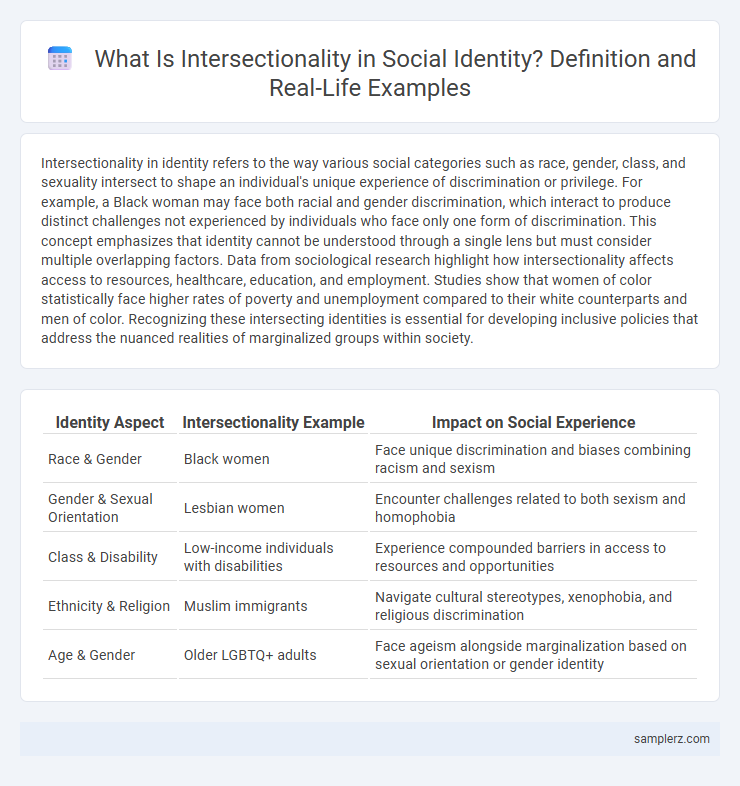Intersectionality in identity refers to the way various social categories such as race, gender, class, and sexuality intersect to shape an individual's unique experience of discrimination or privilege. For example, a Black woman may face both racial and gender discrimination, which interact to produce distinct challenges not experienced by individuals who face only one form of discrimination. This concept emphasizes that identity cannot be understood through a single lens but must consider multiple overlapping factors. Data from sociological research highlight how intersectionality affects access to resources, healthcare, education, and employment. Studies show that women of color statistically face higher rates of poverty and unemployment compared to their white counterparts and men of color. Recognizing these intersecting identities is essential for developing inclusive policies that address the nuanced realities of marginalized groups within society.
Table of Comparison
| Identity Aspect | Intersectionality Example | Impact on Social Experience |
|---|---|---|
| Race & Gender | Black women | Face unique discrimination and biases combining racism and sexism |
| Gender & Sexual Orientation | Lesbian women | Encounter challenges related to both sexism and homophobia |
| Class & Disability | Low-income individuals with disabilities | Experience compounded barriers in access to resources and opportunities |
| Ethnicity & Religion | Muslim immigrants | Navigate cultural stereotypes, xenophobia, and religious discrimination |
| Age & Gender | Older LGBTQ+ adults | Face ageism alongside marginalization based on sexual orientation or gender identity |
Exploring Intersectionality: Understanding Social Identity Layers
Intersectionality examines how overlapping social identities such as race, gender, class, and sexuality create unique experiences of privilege and oppression. For example, a Black woman may face discrimination differently than a white woman or a Black man, highlighting the complexity of social identity layers. Understanding these intersections is crucial for addressing systemic inequalities in social justice initiatives.
The Interplay of Race, Gender, and Class in Everyday Life
Race, gender, and class intersect to shape individuals' experiences of privilege and oppression in everyday life, influencing access to resources, social status, and opportunities. Women of color in low-income communities often face compounded discrimination that limits employment prospects and perpetuates socioeconomic inequalities. This interplay highlights how overlapping social identities create unique challenges and social dynamics beyond isolated categories of race, gender, or class.
When Sexual Orientation Meets Culture: A Case of Double Marginalization
Sexual orientation intersects with cultural identity to create unique experiences of double marginalization, where individuals face exclusion both within their ethnic communities and the broader LGBTQ+ society. For instance, a queer person of color may encounter homophobia rooted in cultural traditions alongside racial discrimination in predominantly white LGBTQ+ spaces. This intersectionality highlights the complex layers of identity that impact social inclusion and access to support.
How Disability and Ethnicity Shape Unique Life Experiences
Disability and ethnicity intersect to create distinct challenges and opportunities that influence access to education, employment, and healthcare within marginalized communities. Individuals with disabilities from ethnic minority backgrounds often face compounded social stigmas and systemic barriers, resulting in disparities in resource availability and social inclusion. This intersectionality highlights the necessity for culturally informed policies that address both physical accessibility and ethnic diversity to promote equity and empowerment.
Religion and Gender Identity: Navigating Conflicting Expectations
Navigating conflicting expectations often challenges individuals whose identities intersect across religion and gender identity, as religious doctrines may prescribe specific gender roles that clash with personal gender expression. For instance, transgender individuals in conservative religious communities frequently face exclusion or pressure to conform, resulting in internal conflicts and social marginalization. Understanding this intersectionality highlights the need for inclusive religious spaces that respect diverse gender identities while honoring faith traditions.
Immigrant Status and Socioeconomic Barriers in Identity Formation
Immigrant status significantly shapes identity formation, intertwining with socioeconomic barriers to impact access to education, employment, and healthcare. Individuals navigating cultural adaptation while facing financial constraints often experience complex social marginalization, influencing their self-perception and community belonging. This intersectionality highlights challenges in policy development aimed at supporting immigrant integration and economic empowerment.
Intersectionality in the LGBTQ+ Community: Beyond Single-Axis Analysis
Intersectionality in the LGBTQ+ community reveals how overlapping identities--such as race, gender, and socioeconomic status--shape unique experiences of discrimination and privilege. Black transgender women, for instance, face compounded challenges related to both racial and gender identity, impacting access to healthcare and safety. Understanding these intersecting factors is essential for creating inclusive policies that address the diverse realities within the LGBTQ+ population.
Indigenous Women and the Intersections of Oppression
Indigenous women face unique forms of oppression that intersect race, gender, and colonial history, resulting in compounded social, economic, and political marginalization. Discrimination in healthcare, education, and legal systems disproportionately affects Indigenous women, exacerbating issues like violence and poverty. Understanding these intersecting identities is crucial for creating policies that address the specific challenges faced by Indigenous women within broader social justice movements.
Aging, Ageism, and Intersectional Challenges in Society
Ageism intersects with other social identities such as race, gender, and socioeconomic status, creating compounded challenges for older adults. For example, older women of color often face discrimination that combines age-related stereotypes with racial and gender biases, impacting their access to healthcare and employment opportunities. This intersectionality reveals how overlapping systems of oppression exacerbate vulnerability and social exclusion in aging populations.
Intersectionality in Activism: Building Inclusive Social Movements
Intersectionality in activism acknowledges overlapping social identities such as race, gender, class, and sexual orientation to address systemic inequalities comprehensively. Movements like Black Lives Matter and LGBTQ+ rights campaigns exemplify inclusive strategies that honor diverse experiences and promote equity. Emphasizing intersectionality fosters solidarity, ensuring that marginalized voices within social justice efforts are recognized and empowered.

example of intersectionality in identity Infographic
 samplerz.com
samplerz.com